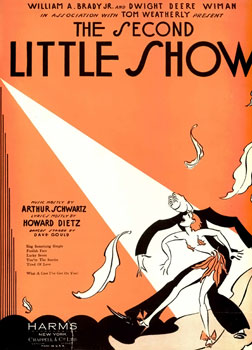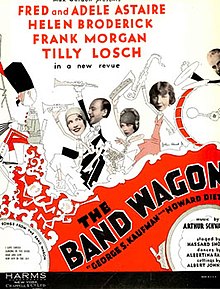
Fred Astaire was an American dancer, actor, singer, choreographer, and presenter. He is widely regarded as the "greatest popular-music dancer of all time". He received numerous accolades including an Honorary Academy Award, three Primetime Emmy Awards, a BAFTA Award, two Golden Globe Awards, and a Grammy Award. He was honored with the Film Society of Lincoln Center tribute in 1973, the Kennedy Center Honors in 1978, and AFI Life Achievement Award in 1980. He was inducted into the Hollywood Walk of Fame in 1960, American Theatre Hall of Fame in 1972, and the Television Hall of Fame in 1989.

The Band Wagon is a 1953 American musical romantic comedy film directed by Vincente Minnelli, starring Fred Astaire and Cyd Charisse. It tells the story of an aging musical star who hopes a Broadway show will restart his career. However, the play's director wants to make it a pretentious retelling of the Faust legend and brings in a prima ballerina who clashes with the star. Along with Singin' in the Rain (1952), it is regarded as one of the finest Metro-Goldwyn-Mayer musicals, although it was a modest box-office success on first release.

Adele Astaire Douglass, was an American dancer, stage actress, and singer. After beginning work as a dancer and vaudeville performer at the age of nine, Astaire built a successful performance career with her younger brother, Fred Astaire.

Jean Schwartz was a Hungarian-born Jewish American composer and pianist. He is best known for his work writing the scores for more than 30 Broadway musicals, and for his creation of more than 1,000 popular songs with the lyricist William Jerome. Schwartz and Jerome also performed together on the vaudeville stage in the United States; sometimes in collaboration with Maude Nugent, Jerome's wife, and the Dolly Sisters. Schwartz was married to Jenny Dolly from 1913-1921.

Arthur Schwartz was an American composer and film producer, widely noted for his songwriting collaborations with Howard Dietz.

Howard Dietz was an American publicist, lyricist, and librettist, best remembered for his songwriting collaboration with Arthur Schwartz.

Gay Divorce is a musical with music and lyrics by Cole Porter and book by Dwight Taylor, adapted by Kenneth Webb and Samuel Hoffenstein. It was Fred Astaire's last Broadway show and featured the hit song "Night and Day" in which Astaire danced with co-star Claire Luce.

That's Entertainment! is a 1974 American compilation film released by Metro-Goldwyn-Mayer to celebrate the studio's 50th anniversary. The success of the retrospective prompted a 1976 sequel, the related 1985 film That's Dancing!, and a third installment in 1994.
"That's Entertainment!" is a popular song with music written by Arthur Schwartz and lyrics by Howard Dietz. The song was published in 1952 and was written especially for the 1953 Metro-Goldwyn-Mayer musical film The Band Wagon. The song is performed in the film by Jack Buchanan supported by Fred Astaire, Nanette Fabray, and Oscar Levant.
"Dancing in the Dark" is a popular American song, with music by Arthur Schwartz and lyrics by Howard Dietz, that was introduced by John Barker with Tilly Losch dancing in the 1931 revue The Band Wagon. The song was first recorded by Bing Crosby on August 19, 1931 with Studio Orchestra directed by Victor Young, staying on the pop charts for six weeks, peaking at #3, and helping to make it a lasting standard.
Leo F. Reisman was an American violinist and bandleader in the 1920s and 1930s. Born and reared in Boston, Massachusetts, United States, he was of Jewish ancestry, from German immigrants who immigrated to the United States in the 19th century. Inspired by the Russian-American violinist Jascha Heifetz, Reisman studied violin as a young man. After being rejected by the Boston Symphony Orchestra, he formed his own band in 1919. He became famous for having over 80 hits on the popular charts during his career. Jerome Kern called Reisman's orchestra "The String Quartet of Dance Bands".

Funny Face is a 1927 musical composed by George Gershwin, with lyrics by Ira Gershwin, and book by Fred Thompson and Paul Gerard Smith. When it opened on Broadway on November 22, 1927, as the first show performed in the newly built Alvin Theatre, it starred Fred Astaire and his sister Adele Astaire. It was in this show that Astaire first danced in evening clothes and a top hat.
"Easter Parade" is a popular song, written by Irving Berlin and published in 1933. Berlin originally wrote the melody in 1917, under the title "Smile and Show Your Dimple", as a "cheer up" song for a girl whose man has gone off to fight in World War I. A recording of "Smile and Show Your Dimple" by Sam Ash enjoyed modest success in 1918.
"I Guess I'll Have to Change My Plan" is a popular song published in 1929, with music by Arthur Schwartz and lyrics by Howard Dietz.
Inside U.S.A. is a musical revue by Arthur Schwartz (music) and Howard Dietz (lyrics). It was loosely based on the book Inside U.S.A. by John Gunther. Sketches were written by Arnold M. Auerbach, Moss Hart, and Arnold B. Horwitt.

Revenge with Music is a musical comedy with book and lyrics by Howard Dietz and music by Arthur Schwartz, that opened on Broadway in 1934. This was the first "book" musical by Dietz and Schwartz.

The Little Show was a musical revue with lyrics by Howard Dietz and music by Arthur Schwartz. It was the first of 11 musicals that featured the songs of Dietz and Schwartz. The revue opened at the Music Box Theatre on Broadway on April 30, 1929 and ran for 321 performances until February 1930.

The Second Little Show is a musical revue with lyrics by Howard Dietz and music mostly by Arthur Schwartz.
Up and Down Broadway is a musical revue in two acts with music by Jean Schwartz, lyrics by William Jerome, and a book Edgar Smith. The musical's loose plot concerns the god Apollo who arrives in New York City in the accompany of other Greek deities vowing to improve the theatrical tastes of the American public. In the end they decide Broadway knows more about great entertainment than the Greek gods do. The musical was written as a starring vehicle for Eddie Foy who portrayed the main servant of Apollo, Momus, and provided much of the work's comedic thrust.












